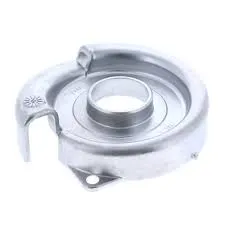Mobile:+86-311-808-126-83
Email:info@ydcastings.com
impeller working
Understanding Impeller Working Principles
An impeller is a crucial component used in various types of machinery, particularly in pumps and turbines. Its primary function is to convert mechanical energy into kinetic energy, which facilitates the movement of fluids such as water, gas, or oil. This article delves into the working principles of impellers, their types, and their applications across different industries.
The Basic Function of an Impeller
At its core, an impeller operates by spinning in a circular motion, sparking the movement of the fluid surrounding it. This is generally achieved through a rotating shaft connected to a motor or turbine. As the impeller spins, it creates a low-pressure area at its center, drawing the fluid into its inlet. The design of the impeller's blades is critical; their shape, size, and angle determine how effectively fluid is accelerated and directed towards the outlet.
Types of Impellers
Impellers come in various designs, each tailored for specific applications. The most common types include
1. Open Impellers Characterized by blades that are not enclosed by a shroud, open impellers are ideal for transporting liquids with suspended solids. They are easier to manufacture and facilitate better mixing but might have lower efficiency for certain fluid types.
2. Closed Impellers These consist of blades enclosed between two shrouds, providing greater efficiency and better hydraulic performance. Closed impellers are preferred for applications requiring higher pressures and where cavitation is a concern.
3. Semi-Open Impellers A compromise between open and closed designs, semi-open impellers have a partial shroud. They offer some advantages in terms of efficiency while still allowing for handling abrasive or viscous fluids.
4. Multi-Stage Impellers In applications where high pressures are necessary, multi-stage impellers are used. These consist of multiple impeller sets arranged in series, allowing for significant pressure gains and efficient fluid transport over long distances.
The Working Mechanism
impeller working

The working mechanism of an impeller can be explained through its interaction with fluid dynamics. As the impeller rotates, it imparts kinetic energy to the fluid, causing it to flow radially outward. This movement results in a pressure difference, which pushes the fluid through the system. The principles of Bernoulli’s equation play a significant role here, linking fluid velocity to pressure changes.
Understanding the flow characteristics of fluids is essential when designing an impeller. Factors such as Reynolds number, viscosity, and flow regime impact how the fluid behaves as it passes through the impeller. Engineers must meticulously calculate these variables to optimize performance and efficiency.
Applications of Impellers
Impellers find applications in various fields, including
- Water Supply and Treatment In municipal and industrial water systems, impellers are used in pumps to transport and treat water efficiently.
- Chemical Processing In reactors and mixers, impellers facilitate the mixing of chemicals and the transport of reactants and products.
- HVAC Systems In heating, ventilation, and air conditioning systems, impellers boost airflow and improve thermal efficiency.
- Marine Applications Impellers are used in boat propellers and jet boats, where they effectively propel vessels through water.
Conclusion
In summary, impellers are indispensable components in fluid mechanics, guiding and enhancing the movement of fluids in numerous applications. Understanding their working principles, designs, and the science behind fluid dynamics can lead to more efficient and effective machinery in various industries. As technology advances, the development of more sophisticated impeller designs will continue to play an integral role in enhancing operational efficiencies across multiple sectors.
-
Impeller Technology That Powers Precision in Pump SystemsNewsMay.22,2025
-
Valve Durability Begins with Quality Cast Iron ComponentsNewsMay.22,2025
-
Performance Cooling with Advanced Automobile Water Pump SolutionsNewsMay.22,2025
-
How Motor Housing and Oil Pans Shape Engine PerformanceNewsMay.22,2025
-
How Metal Castings Drive Modern Manufacturing EfficiencyNewsMay.22,2025
-
Exploring the Engineering Behind Valve Body CastingsNewsMay.22,2025











